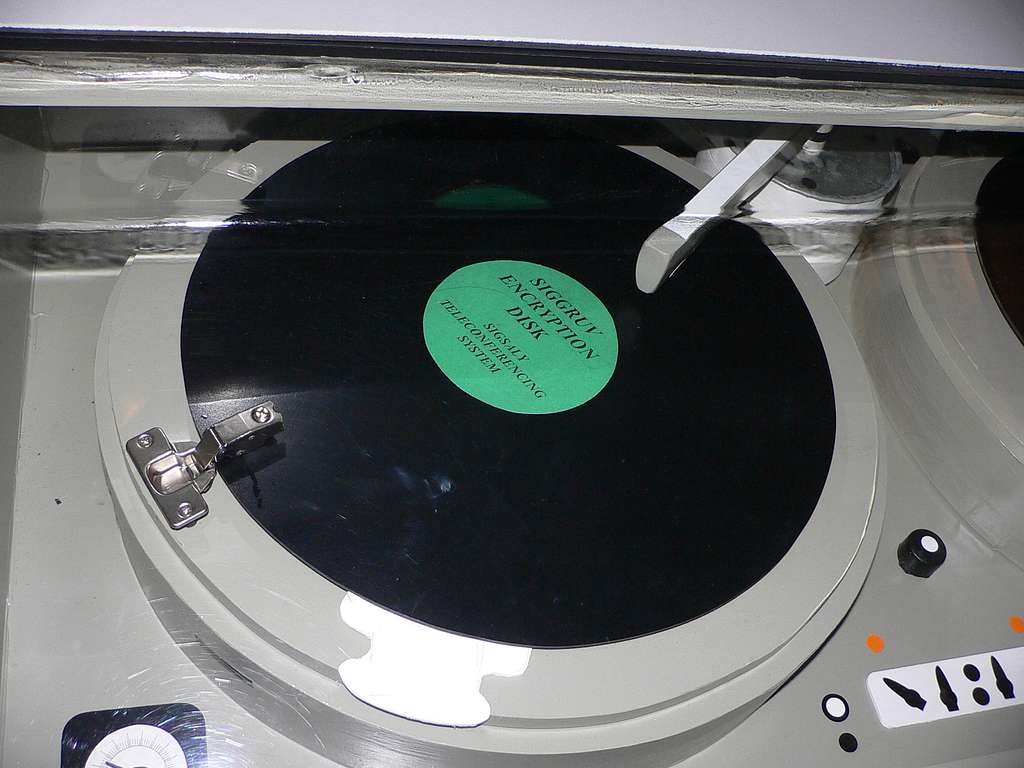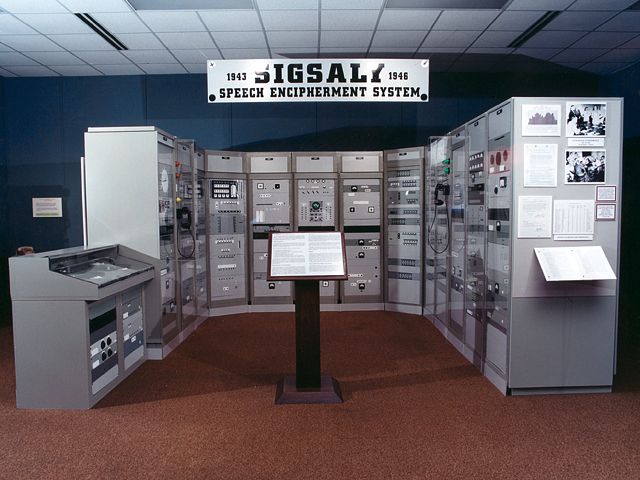By the 1940s, radio and telephone had revolutionized communications in the industrialized world. Its strategic use in warfare, as a way to transmit information and intelligence, was not lost on military personnel. Yet these signals needed to be protected. Especially with radio, it was easy to become an undetected eavesdropper wherever signals could be received. After World War I, the first devices to attempt secure transmission of voice were developed. These were substitution devices that inverted frequencies in a way similar to how alphabetic substitution codes swapped one letter for another. High frequencies were substituted for low frequencies and vice versa. It was easy to make a device that could do this, but the system was also easy to break.
In 1931, Bell Telephone Laboratories developed the A-3 scrambler that was used by Roosevelt and Churchill when they talked on the phone. Although the United States was still not at war in 1941, they were aiding the Allies with materiel, and secure calls had to be made. The A-3 worked by dividing the voice frequency into five subbands. Each of these was inverted. On top of the measure of substitution, it also used transposition, with the voice shifted from one subband to another every twenty seconds.
The security of the A-3 was eventually compromised by Germans based at a radio post in South Holland who had been intercepting the British prime minister’s telephone calls in 1941. Aware that their system was insecure, the situation was becoming intolerable for the Allies. Tensions had been mounting between the US and Japan, and a “warning of war” had come in late November, but no one knew when or where. On December 7, 1941, American cryptanalysts were hard at work breaking a long ciphertext intercepted from Tokyo to the Japanese embassy in Washington D.C. The team of codebreaker William Friedman, of the Signals Intelligence Service, had broken Japanese diplomatic ciphers before, but this naval cipher, scrambled in fourteen parts, was impenetrable.
One part they did tease out: the Japanese embassy had been instructed to destroy their cryptography equipment and meet with the US Secretary of War, suggesting that armed conflict seemed imminent. Admiral Stark, Chief of Naval Operations, needed to send Admiral Kimmel at Pearl Harbor another message to reinforce the warning of war. Stark knew the A-3 scrambler was no longer secure, so he chose to send his message by radio. However, atmospheric propagation conditions over the Pacific stalled his message in its tracks. The next option was to send a message by undersea cable via Western Union. Unfortunately, by the time it arrived the battleships of the Pacific Fleet had already been bombed and the Japanese planes were flying back to their bases.
The need for secure transmissions became even more paramount as the United States entered the war. In 1942, the Army contracted Bell Labs to assist with the communication problem and create “indestructible speech” that could withstand attempts at code breaking. From this effort, the revolutionary twelve-channel SIGSALY system was born. SIGSALY was not an acronym, just a codename for the project. To create SIGSALY, workers sifted through over eighty patents in the general area of voice security, settling on Homer Dudley’s vocoder to form the basis of the system. For SIGSALY, a twelve-channel vocoder was used. Ten of the channels measured the power of the voice signal in the audio portion of the frequency spectrum where most talking occurs, while two channels were devoted to “pitch” information and whether or not unvoiced (hiss) energy was present. The vocoder enciphered the speech as it went out over phone or radio. In order to be deciphered at each end of the conversation, an audio crypto-key was needed. This came in the form of vinyl records.
From the standpoint of music history, it is interesting to note, as Dave Tompkins did in his book How to Wreck a Nice Beach: The Vocoder from WWII to Hip-Hop, that the SIGSALY system employed two-turntables and a microphone. The classified name for this vinyl part of the operation was SIGGRUV, while the vinyl records were produced by the Muzak Corporation, a company famous for the creation of elevator music. The sounds on these records weren’t aimed at soothing weekend shoppers or people sitting in waiting rooms, but rather contained random white noise, like channel 3 on an old television set. The noise was created by the output of very large mercury-rectifier tubes that were four inches in diameter and over a foot high. These generated wide band thermal noise that was sampled every twenty milliseconds. The samples were then quantized into six levels of equal probability. The level information was converted into channels of a frequency-shift keyed audio tone signal recorded onto a vinyl master. From the master, only three copies of a key segment were ever made. If any SIGGRUV vinyl still exists, and for security reasons they shouldn’t, those grooves are critically rare.

It had to be insured that no pattern could be detected, so the records had to be random noise. Even if the equipment had somehow been duplicated by the Axis powers, the communications would still be uncompromised, as they still required the matching vinyl crypto key at each terminal. This made the transportation of these records, via armored truck, the most secure since Edison invented the phonograph. Just as the masters were destroyed after making three keys, each vinyl key was only ever to be played once, as operators were instructed to burn them after playing. The official instruction read, “The used project record should be cut-up and placed in an oven and reduced to a plastic biscuit of ‘Vinylite.’” As another precaution against the grooves falling into enemy hands, the turntables themselves had a self-destruct mechanism built into them that could be activated in case one of the terminals was compromised. Thinking of all this adds a fascinating new dimension to the idea of a DJ battle.
Synchronizing turntables at two different terminals across the globe was another technical hurdle Bell Labs overcame, which was no small feat given that if a needle jumped or the system went out of sync, only garbled speech was heard. At the agreed upon time, say 1200 GMT, operators listened for the click of the phonograph being cued to the first groove. The turntables were started by releasing a clutch for the synchronous motor that kept the turntable running at a precise speed. Fine adjustments were made using fifty hertz phase shifters (Helmholtz coils) to account for delays in transmission time. The operators would listen for full quieting of the audio as synchronization was established. Oscilloscopes and shortwave receivers were also used to keep systems locked to international time.
A complete SIGSALY system contained about forty racks of heavy equipment comprising vacuum tubes, relays, synchronous motors, turntables, and custom made electromechanical equipment. In the pre-transistor era, all of this gear required a heavy load of power, so cooling systems were also required to keep it all from getting fried from the heat. The average weight of a set up was about fifty-five tons.
The system passed the inspection of Alan Turing, “the father of modern computer science,” if not his test. He had been briefly involved with the project on the British side, just as Claude Shannon had been in America. On July 15, 1943, the inaugural connection was established between the Pentagon and a room in the basement below Selfridges Department Store in London. Eventually a total of twelve SIGSALY encipherment terminals were established, including locations in Paris, Algiers, Manila, Guam, Australia, and one on a barge that ended up in the Tokyo Bay. In the year 1945 alone, the system trafficked millions of words between the Allies.
To keep all of this operational, a special division of the Army Signal Corp was set up: the 805th Signal Service Company. Training commenced in a school set up by Bell Labs and soldiers were sent to various locations, requiring security clearances and a firm grasp on the cutting edge technology they were tasked to operate and maintain. For every eight hours of operation, the SIGSALY systems required sixteen hours of maintenance and calibration.
In putting the system together, eight remarkable engineering “firsts” were achieved. A review conducted by the Institute of Electronic and Electrical Engineers in 1983 lists them as follows:
- The first realization of enciphered telephony
- The first quantized speech transmission
- The first transmission of speech by Pulse Code Modulation (PCM)
- The first use of companded PCM
- The first examples of multilevel Frequency Shift Keying (FSK)
- The first useful realization of speech bandwidth compression
- The first use of FSK – FDM (Frequency Shift Keying-Frequency Division Multiplex) as a viable transmission method over a fading medium
- The first use of a multilevel “eye pattern” to adjust the sampling intervals (a new, and important, instrumentation technique)
SIGSALY left the world with a rich inheritance that spans developments in cryptology and digital communications, a legacy that ticks away in the background of history every time someone hits the decks with two turntables and a microphone.
The Radio Phonics Laboratory by Justin Patrick Moore is published by Velocity Press


